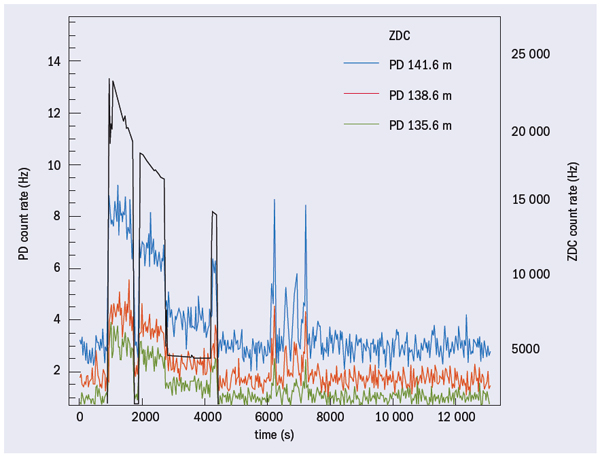
Measurements at RHIC at Brookhaven National Laboratory (BNL) have provided the first observations at a particle collider of a long-anticipated physical process that may eventually limit the performance of the LHC at CERN. Known as bound-free pair production, the process leads to the formation of one-electron ions that stray out of the beam and might deposit enough energy to quench the LHC’s superconducting magnets. It is thus vitally important to estimate the effect at the LHC.
RHIC typically collides gold nuclei at an energy of 19.7 TeV (100 GeV/nucleon) and, in its heavy-ion programme, the LHC will collide lead nuclei at 574 TeV (2759 GeV/nucleon). The main aim in these heavy-ion collisions is to “melt” the constituent protons and neutrons of the nuclei into a plasma of strongly interacting quarks and gluons. However, heavy-ion collisions also provide access to electromagnetic forces of phenomenal intensity, as relativistic length contraction dramatically squashes the electric field lines emerging from each highly charged nucleus into a flat pancake shape. When these “pancakes” interact, large numbers of electron–positron pairs are ripped out of the vacuum. In some cases, the electron of the pair is attached to one or other nucleus, converting a small fraction of the beam to one-electron ions. These soon stray from the path of the main beam and are lost in a well-defined patch of the beam-pipe surface.
The beam loss initiates a shower of particles (hadrons) that cause localized heating. At RHIC, the rate and energy of the collisions and the field in the magnets are all low enough that there is no danger of the magnets quenching. At the LHC, however, the heating will be several thousand times greater (up to 25 W) and researchers predict that the process will be a direct limit on the luminosity of lead-ion collisions. The LHC calculations depend not only on the theoretical cross-section but also tracking of ions to their impact points, the development of the hadronic showers, the propensity of the magnets to quench and the response of beam-loss monitors outside of the cryostats.
A team from CERN, BNL and Lawrence Berkeley National Laboratory has now measured this process for the first time, using beams of 6.3 TeV copper nuclei at RHIC and an array of photodiodes to detect the showers (Bruce et al. 2007). The team mounted the diodes on the outside of the magnet cryostat downstream from the interaction region for one of the experiments (PHENIX).
The data correlated well in time with the measured luminosity in RHIC, and were localized in position, close to the predicted impact point. The count rates in the photodiodes varied from 1 to 20 Hz, depending on their position and luminosity, with the maximum at 140.5 m from the interaction point. The results agree reasonably well with predictions, validating the LHC methodology and confirming the order of magnitude of the theoretical cross-section.








